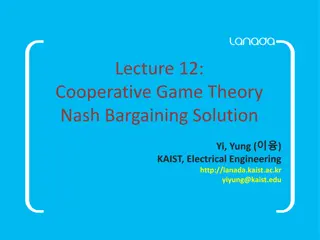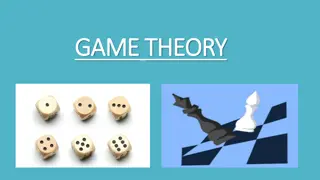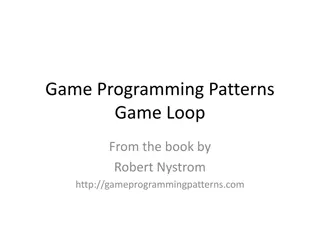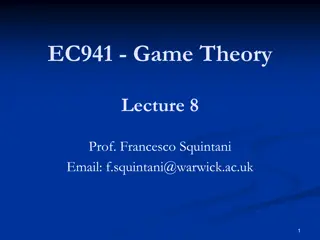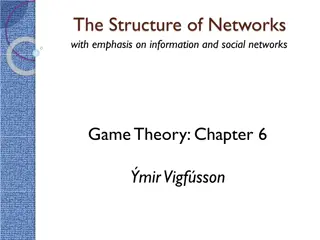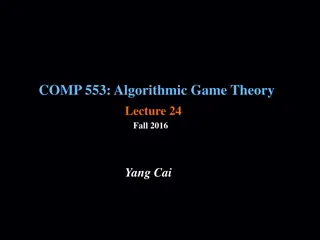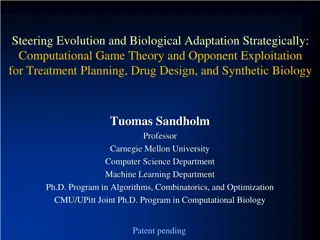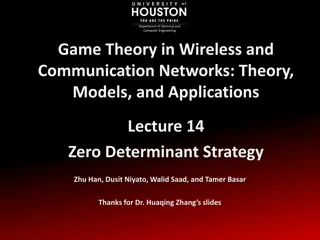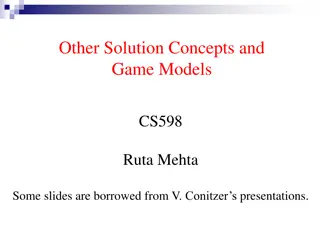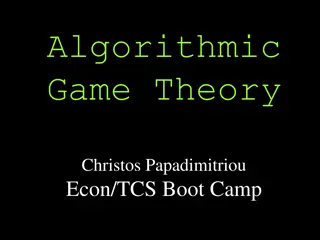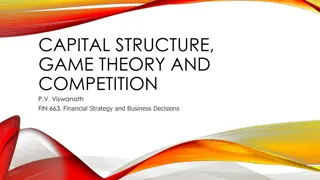Understanding Game Theory: Applications and Concepts
Game theory delves into systems of interacting agents where outcomes depend on each agent's actions. Explored in various fields, it helps in agent design and mechanism design for optimal strategies and rule-setting. Topics covered include Nash equilibrium, coordination games, anti-coordination games, the Ultimatum Game, and mechanism design through inverse game theory.
Download Presentation

Please find below an Image/Link to download the presentation.
The content on the website is provided AS IS for your information and personal use only. It may not be sold, licensed, or shared on other websites without obtaining consent from the author. Download presentation by click this link. If you encounter any issues during the download, it is possible that the publisher has removed the file from their server.
E N D
Presentation Transcript
CS 440/ECE448 Lecture 10: Game Theory Slides by Svetlana Lazebnik, 9/2016 Modified by Mark Hasegawa-Johnson, 2/2018 https://en.wikipedia.org/wiki/Prisoner s_dilemma
Game theory Game theory deals with systems of interacting agents where the outcome for an agent depends on the actions of all the other agents Applied in sociology, politics, economics, biology, and, of course, AI Agent design: determining the best strategy for a rational agent in a given game Mechanism design: how to set the rules of the game to ensure a desirable outcome
http://www.wired.com/2015/09/facebook-doesnt-make-much-money-couldon-purpose/http://www.wired.com/2015/09/facebook-doesnt-make-much-money-couldon-purpose/
Outline of todays lecture Nash equilibrium, Dominant strategy, and Pareto optimality Stag Hunt: Coordination Games Chicken: Anti-Coordination Games, Mixed Strategies The Ultimatum Game: Continuous and Repeated Games Mechanism Design: Inverse Game Theory
Nash Equilibria, Dominant Strategies, and Pareto Optimal Solutions
Simultaneous single-move games Players must choose their actions at the same time, without knowing what the others will do Form of partial observability Normal form representation: Player 1 0,0 1,-1 -1,1 -1,1 0,0 1,-1 Player 2 1,-1 -1,1 0,0 Payoff matrix (Player 1 s utility is listed first) Is this a zero-sum game?
Prisoners dilemma Two criminals have been arrested and the police visit them separately If one player testifies against the other and the other refuses, the one who testified goes free and the one who refused gets a 10-year sentence If both players testify against each other, they each get a 5-year sentence If both refuse to testify, they each get a 1-year sentence Alice: Testify Alice: Refuse Bob: Testify -5,-5 -10,0 Bob: Refuse 0,-10 -1,-1
Prisoners dilemma Alice s reasoning: Suppose Bob testifies. Then I get 5 years if I testify and 10 years if I refuse. So I should testify. Suppose Bob refuses. Then I go free if I testify, and get 1 year if I refuse. So I should testify. Nash equilibrium: A pair of strategies such that no player can get a bigger payoff by switching strategies, provided the other player sticks with the same strategy (Testify, testify) is a dominant strategy equilibrium Alice: Testify Alice: Refuse Bob: Testify -5,-5 -10,0 Bob: Refuse 0,-10 -1,-1
Prisoners dilemma Dominant strategy: A strategy whose outcome is better for the player regardless of the strategy chosen by the other player Pareto optimal outcome: It is impossible to make one of the players better off without making another one worse off In Prisoner s dilemma, Nash equilibrium = each player plays his\her dominant strategy Nash equilibrium Pareto optimal outcomes Other games can be constructed in which there is no dominant strategy we ll see some later Alice: Testify Alice: Refuse Bob: Testify -5,-5 -10,0 Bob: Refuse 0,-10 -1,-1
Recall: Multi-player, non-zero-sum game 4,3,2 4,3,2 1,5,2 4,3,2 7,4,1 1,5,2 7,7,1
Prisoners dilemma in real life Defect Cooperate Price war Arms race Steroid use Diner s dilemma Collective action in politics Lose big win big Defect Lose lose Win big lose big Cooperate Win win http://en.wikipedia.org/wiki/Prisoner s_dilemma
Is there any way to get a better answer? Superrationality Assume that the answer to a symmetric problem will be the same for both players Maximize the payoff to each player while considering only identical strategies Not a conventional model in game theory same thing as the Categorical Imperative? Repeated games If the number of rounds is fixed and known in advance, the equilibrium strategy is still to defect If the number of rounds is unknown, cooperation may become an equilibrium strategy
Stag hunt Hunter 1: Stag Hunter 1: Hare Hunter 2: Stag 2,2 1,0 Hunter 2: Hare 0,1 1,1 Both hunters cooperate in hunting for the stag each gets to take home half a stag Both hunters defect, and hunt for rabbit instead each gets to take home a rabbit One cooperates, one defects the defector gets a bunny, the cooperator gets nothing at all
Stag hunt Hunter 1: Stag Hunter 1: Hare Hunter 2: Stag 2,2 1,0 Hunter 2: Hare 0,1 1,1 What is the Pareto Optimal solution? Is there a Nash Equilibrium? Is there a Dominant Strategy for either player? Model for cooperative activity under conditions of incomplete information (the issue: trust)
Prisoners dilemma vs. stag hunt Stag hunt Prisoner dilemma Cooperate Defect Cooperate Defect Win big lose big Win big win big Cooperate Win win Cooperate Win lose Lose big win big Defect Lose win Win win Defect Lose lose Players improve their winnings by defecting unilaterally Players reduce their winnings by defecting unilaterally
Chicken: Anti-Coordination Games, Mixed Strategies
Game of Chicken Player 1 S C Player 2 Chicken S -10, -10 -1, 1 Straight C 1, -1 0, 0 Straight Chicken Two players each bet $1000 that the other player will chicken out Outcomes: If one player chickens out, the other wins $1000 If both players chicken out, neither wins anything If neither player chickens out, they both lose $10,000 (the cost of the car) http://en.wikipedia.org/wiki/Game_of_chicken
Prisoners dilemma vs. Chicken Chicken Prisoner dilemma Cooperate Defect Chicken Straight Win big Lose big Chicken Nil Nil Win Lose Cooperate Win win Lose big Lose big Lose big Win big Straight Lose Win Defect Lose Lose Players can t improve their winnings by unilaterally cooperating The best strategy is always the opposite of what the other player does
Game of Chicken Player 1 S C Player 2 Chicken S -10, -10 -1, 1 Straight C 1, -1 0, 0 Straight Chicken Is there a dominant strategy for either player? Is there a Nash equilibrium? (straight, chicken) or (chicken, straight) Anti-coordination game: it is mutually beneficial for the two players to choose different strategies Model of escalated conflict in humans and animals (hawk-dove game) How are the players to decide what to do? Pre-commitment or threats Different roles: the hawk is the territory owner and the dove is the intruder, or vice versa http://en.wikipedia.org/wiki/Game_of_chicken
Mixed strategy equilibria Player 1 S C Player 2 Chicken S -10, -10 -1, 1 Straight C 1, -1 0, 0 Straight Chicken Mixed strategy: a player chooses between the moves according to a probability distribution Suppose each player chooses S with probability 1/10. Is that a Nash equilibrium? Consider payoffs to P1 while keeping P2 s strategy fixed The payoff of P1 choosing S is (1/10)( 10) + (9/10)1 = 1/10 The payoff of P1 choosing C is (1/10)( 1) + (9/10)0 = 1/10 Can P1 change their strategy to get a better payoff? Same reasoning applies to P2
Finding mixed strategy equilibria P1: Choose S with prob. p P1: Choose C with prob. 1-p P2: Choose S with prob. q -10, -10 -1, 1 P2: Choose C with prob. 1-q 1, -1 0, 0 Expected payoffs for P1 given P2 s strategy: P1 chooses S: q( 10) +(1 q)1 = 11q + 1 P1 chooses C: q( 1) + (1 q)0 = q In order for P2 s strategy to be part of a Nash equilibrium, P1 has to be indifferent between its two actions: 11q + 1 = q or q = 1/10 Similarly, p = 1/10
Existence of Nash equilibria Any game with a finite set of actions has at least one Nash equilibrium (which may be a mixed-strategy equilibrium) If a player has a dominant strategy, there exists a Nash equilibrium in which the player plays that strategy and the other player plays the best response to that strategy If both players have strictly dominant strategies, there exists a Nash equilibrium in which they play those strategies
Computing Nash equilibria For a two-player zero-sum game, simple linear programming problem For non-zero-sum games, the algorithm has worst-case running time that is exponential in the number of actions For more than two players, and for sequential games, things get pretty hairy
Nash equilibria and rational decisions If a game has a unique Nash equilibrium, it will be adopted if each player is rational and the payoff matrix is accurate doesn t make mistakes in execution is capable of computing the Nash equilibrium believes that a deviation in strategy on their part will not cause the other players to deviate there is common knowledge that all players meet these conditions http://en.wikipedia.org/wiki/Nash_equilibrium
The Ultimatum Game: Continuous and Repeated Games
Continuous actions: Ultimatum game Alice and Bob are given a sum of money S to divide Alice picks A, the amount she wants to keep for herself Bob picks B, the smallest amount of money he is willing to accept If S A B, Alice gets A and Bob gets S A If S A < B, both players get nothing What is the Nash equilibrium? Alice offers Bob the smallest amount of money he will accept: S A = B Alice and Bob both want to keep the full amount: A = S, B = S (both players get nothing) How would humans behave in this game? If Bob perceives Alice s offer as unfair, Bob will be likely to refuse Is this rational? Maybe Bob gets some positive utility for punishing Alice? http://en.wikipedia.org/wiki/Ultimatum_game
Sequential/repeated games and threats: Chain store paradox A monopolist has branches in 20 towns and faces 20 competitors successively Threat: respond to in with aggressive Competitor In Out Monopolist (1, 5) Aggressive Cooperative (2, 2) (0, 0) https://en.wikipedia.org/wiki/Chainstore_paradox
Mechanism Design: Inverse Game Theory
Mechanism design (inverse game theory) Assuming that agents pick rational strategies, how should we design the game to achieve a socially desirable outcome? We have multiple agents and a center that collects their choices and determines the outcome
Auctions Goals Maximize revenue to the seller Efficiency: make sure the buyer who values the goods the most gets them Minimize transaction costs for buyer and sellers
Ascending-bid auction What s the optimal strategy for a buyer? Bid until the current bid value exceeds your private value Usually revenue-maximizing and efficient, unless the reserve price is set too low or too high Disadvantages Collusion Lack of competition Has high communication costs
Sealed-bid auction Each buyer makes a single bid and communicates it to the auctioneer, but not to the other bidders Simpler communication More complicated decision-making: the strategy of a buyer depends on what they believe about the other buyers Not necessarily efficient Sealed-bid second-price auction: the winner pays the price of the second-highest bid Let V be your private value and B be the highest bid by any other buyer If V > B, your optimal strategy is to bid above B in particular, bid V If V < B, your optimal strategy is to bid below B in particular, bid V Therefore, your dominant strategy is to bid V This is a truth revealing mechanism
Dollar auction A malevolent twist on the second-price auction: Highest bidder gets to buy the object, and pays whatever they bid Second-highest bidder is required to pay whatever they bid, but gets nothing at all in return Dramatization: https://www.youtube.com/watch?v=pA-SNscNADk
Dollar auction A dollar bill is auctioned off to the highest bidder, but the second- highest bidder has to pay the amount of his last bid Player 1 bids 1 cent Player 2 bids 2 cents Player 2 bids 98 cents Player 1 bids 99 cents If Player 2 passes, he loses 98 cents, if he bids $1, he might still come out even So Player 2 bids $1 Now, if Player 1 passes, he loses 99 cents, if he bids $1.01, he only loses 1 cent What went wrong? When figuring out the expected utility of a bid, a rational player should take into account the future course of the game What if Player 1 starts by bidding 99 cents?
Regulatory mechanism design: Tragedy of the commons States want to set their policies for controlling emissions Each state can reduce their emissions at a cost of -10 or continue to pollute at a cost of -5 If a state decides to pollute, -1 is added to the utility of every other state What is the dominant strategy for each state? Continue to pollute Each state incurs cost of -5-49 = -54 If they all decided to deal with emissions, they would incur a cost of only -10 each Mechanism for fixing the problem: Tax each state by the total amount by which they reduce the global utility (externality cost) This way, continuing to pollute would now cost -54
Review: Game theory Normal form representation of a game Dominant strategies Nash equilibria Pareto optimal outcomes Pure strategies and mixed strategies Examples of games Mechanism design Auctions: ascending bid, sealed bid, sealed bid second-price, dollar auction






